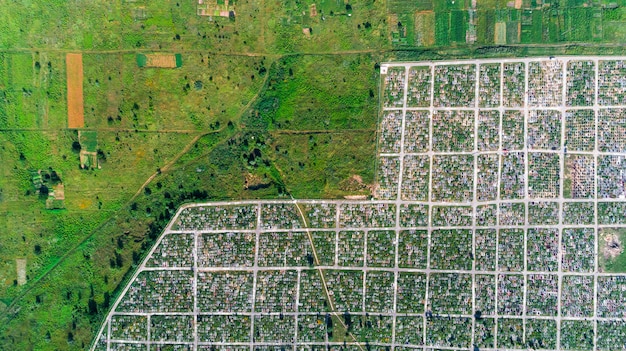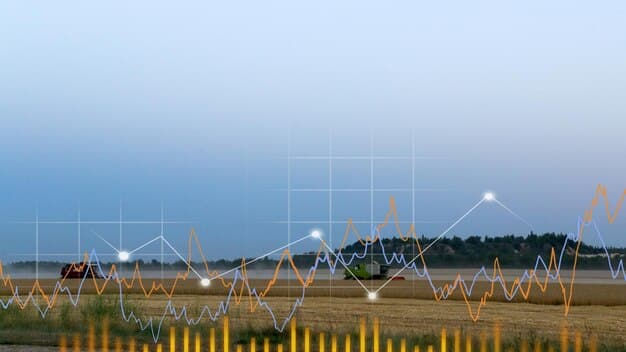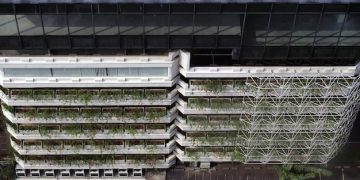Vertical Farming: Revolutionizing Urban Food Production in the US

Exploring the Potential of Vertical Farming for Sustainable Food Production in Urban US Areas reveals how innovative, controlled-environment agriculture can address food security, reduce environmental impact, and enhance community resilience in densely populated regions across the United States.
The challenges of feeding a growing urban population in the United States are becoming increasingly complex. Traditional agriculture faces constraints such as land scarcity, water shortages, and climate change impacts. Exploring the Potential of Vertical Farming for Sustainable Food Production in Urban US Areas, this article delves into how integrating vertical farms into urban landscapes could provide a significant boost to local food production, reduce carbon footprints, and foster community engagement.
The Rise of Vertical Farming in Urban Landscapes
Vertical farming is an innovative approach to agriculture that involves growing crops in vertically stacked layers, often in controlled indoor environments. This method offers considerable advantages over traditional farming, especially in densely populated urban areas where land is scarce and the demand for fresh, locally sourced produce is high. This section explores the growing adoption and importance of vertical farming in transforming the urban food landscape across the United States.
By maximizing space and employing advanced technologies, vertical farms can produce significantly more food per square foot than conventional farms. This enhances food security and enables communities to rely less on distant and potentially unsustainable food sources.
Advantages of Vertical Farming Over Traditional Agriculture
Vertical farming presents numerous benefits that address critical challenges in food production. One key advantage is its ability to optimize resource use.
- Water Conservation: Vertical farms use significantly less water than traditional farms through closed-loop irrigation systems that recycle water.
- Reduced Land Use: By growing crops in stacked layers, vertical farms require minimal land, making them suitable for urban environments.
- Climate Control: Indoor vertical farms can control temperature, humidity, and lighting, ensuring optimal growing conditions year-round.
- Pest and Disease Management: The controlled environment reduces the risk of pests and diseases, minimizing the need for pesticides.
The growth of vertical farming is revolutionizing food production in urban areas, offering a practical and sustainable solution to the challenges faced by traditional agriculture.

Technological Innovations Driving Vertical Farming
The success of vertical farming hinges on technological innovation. Advanced technologies enable precise control over environmental conditions, optimize plant growth, and enhance efficiency. This section explores the key technological innovations that make vertical farming a viable and increasingly attractive option for sustainable food production in urban US areas.
From LED lighting to hydroponics and aeroponics, these technologies enable vertical farms to produce high-quality crops year-round, regardless of external climate conditions.
Key Technologies in Vertical Farming
Several technologies are pivotal in the operation and success of vertical farms. From environmental control systems to advanced growing methods, these innovations make it possible to cultivate crops efficiently in limited spaces.
- LED Lighting: Provides the specific wavelengths of light needed for plant growth, optimizing photosynthesis while minimizing energy consumption.
- Hydroponics: A soilless growing method where plants receive nutrients from a water-based solution, reducing water usage and enhancing nutrient delivery.
- Aeroponics: Plants’ roots are suspended in air and periodically sprayed with a nutrient-rich solution, further conserving water and promoting root health.
- Environmental Control Systems: Regulate temperature, humidity, and air circulation to create optimal growing conditions, ensuring consistent crop yields.
These technological advancements enable vertical farms to achieve higher yields while minimizing resource consumption, making them a sustainable choice for urban agriculture.
Economic Viability and Challenges of Vertical Farming
While vertical farming holds immense promise, its economic viability remains a key consideration. This section explores the costs and benefits associated with vertical farming ventures, addressing challenges related to initial investment, operational expenses, and market competitiveness. It also examines strategies for overcoming these obstacles and making vertical farming economically sustainable.
Understanding the economics of vertical farming is crucial for fostering its adoption and integration into the broader agricultural sector.

Costs and Benefits
The economic landscape of vertical farming is complex, involving both significant initial investments and the potential for long-term profitability.
- Initial Investment: Setting up a vertical farm requires substantial investment in infrastructure, including controlled environment systems, lighting, and hydroponic or aeroponic equipment.
- Operational Costs: Energy consumption, labor, and nutrient solutions contribute to ongoing operational expenses.
- Revenue Generation: Vertical farms can generate revenue by selling high-quality produce directly to consumers, restaurants, and local markets.
- Government Incentives: Various federal and state programs offer financial incentives and grants to support vertical farming initiatives.
Achieving economic viability requires careful planning, efficient resource management, and access to supportive policies and funding opportunities.
Environmental Benefits of Urban Vertical Farms
A significant advantage of vertical farming is its potential to mitigate many of the environmental impacts associated with traditional agriculture. By reducing transportation needs, conserving water, and minimizing pesticide use, vertical farms can contribute to a more sustainable food system. This section focuses on the specific environmental benefits of integrating vertical farms into urban environments.
From reducing carbon emissions to preserving biodiversity, urban vertical farms offer a range of ecological advantages that support a healthier planet.
Specific Environmental Impacts
Urban vertical farms are vital in reducing environmental harm, promoting sustainable ecosystems within city landscapes.
- Reduced Carbon Footprint: Minimizing transportation of goods from farms reduces carbon emissions.
- Water Conservation: Recycling water, reducing the water consumption compared to traditional farming.
- Pest and Disease Reduction: Controlled environments limits the damage pests and diseases, reducing the use of pesticides.
These efforts and environmental benefits help minimize the harm and the environmental impact compared to traditional practices.
Social Impact and Community Engagement
Beyond environmental and economic benefits, vertical farming can play a crucial role in enhancing social equity and community resilience. By providing access to fresh, nutritious food in underserved urban areas, vertical farms can address food insecurity and improve public health outcomes. This section explores the potential social impacts of vertical farming and strategies for fostering community engagement.
From creating local jobs to promoting educational opportunities, urban vertical farms can serve as community hubs that strengthen social bonds and improve quality of life.
Community Engagement
Integrating vertical farms into urban communities requires active community engagement and participation.
- Educational Programs: Schools can use vertical farms to teach students agricultural practices, nutrition, and sustainability.
- Job Creation: Vertical farms can provide employment opportunities for local residents, particularly in areas with high unemployment rates.
- Community Gardens: Integrating vertical farms with community gardens can create shared spaces for growing and learning.
By involving community members in the planning and operation of vertical farms, we can ensure that these initiatives address local needs and contribute to community development.
Policy and Regulatory Frameworks Supporting Vertical Farming
The successful integration of vertical farming into urban landscapes depends on the development of supportive policy and regulatory frameworks. This section discusses the current state of policies related to vertical farming in the US, identifying opportunities for creating an environment that fosters innovation and investment. It examines existing incentives, zoning regulations, and other policy tools that can help promote the growth of vertical farming.
By creating clear and consistent policy frameworks, governments can help unlock the full potential of vertical farming and support the transition to a more sustainable and resilient food system.
“`html
| Key Point | Brief Description |
|---|---|
| 🌱 Resource Efficiency | Vertical farms use less water and land compared to tradional argiculture. |
| 💡 Technological Innovation | LED lights and hydroponics are key in vertical farming. |
| 🤝 Community Engagement | Vertical farms can promote education, jobs, and communities. |
| 🏢 Policy Support | Policies are important to support vertical farming in urban areas. |
“`
Frequently Asked Questions
▼
Vertical farming grows crops in vertically stacked layers, using indoor, controlled environments. This optimizes growing conditions, conserving resources by reducing the dependence on traditional methods.
▼
Benefits include higher crop yields, reduced water usage, minimized transportation costs, and year-round production, leading to greater food security and environmental sustainability.
▼
Key challenges include high initial investment costs, significant energy consumption, and the need for ongoing technological innovation to improve efficiency and profitability.
▼
By producing food locally, vertical farming decreases dependence on distant farms, lowers transportation costs, and provides steady supply of fresh produce, boosting food security, especially in urban food deserts.
▼
Yes, several federal and state programs offer grants, tax incentives, and funding opportunities to support vertical farming projects, promoting sustainable agriculture and innovation.
Conclusion
Exploring the Potential of Vertical Farming for Sustainable Food Production in Urban US Areas, vertical farming promises a resilient food future. Combining technological with community focused initiatives, we can improve our environment, economy and food security.





